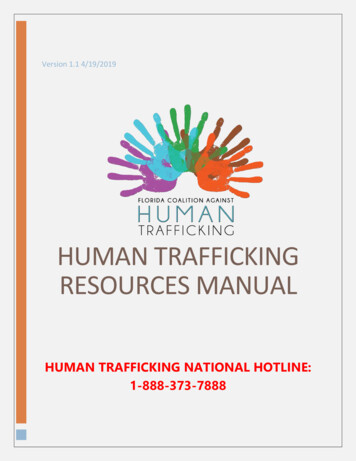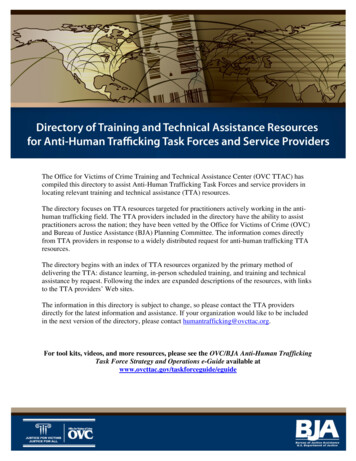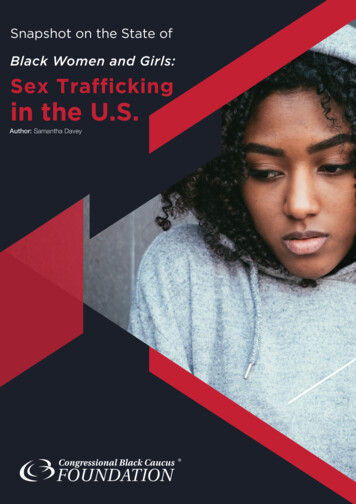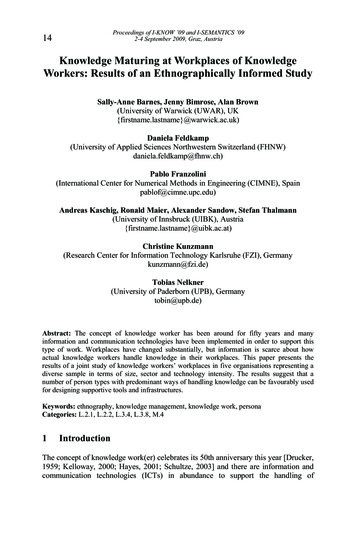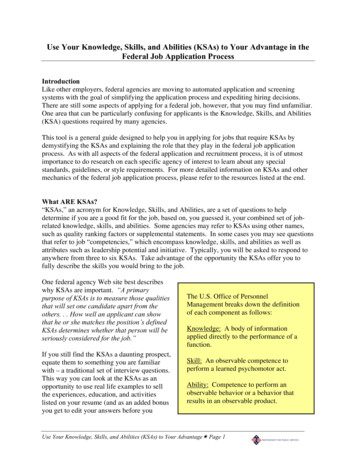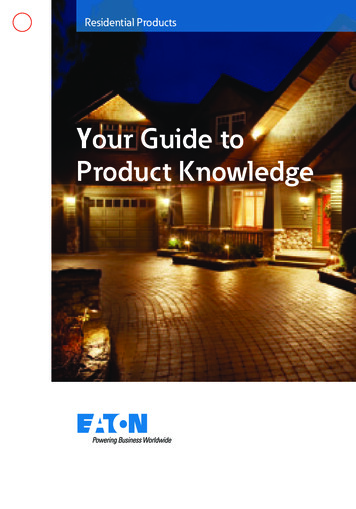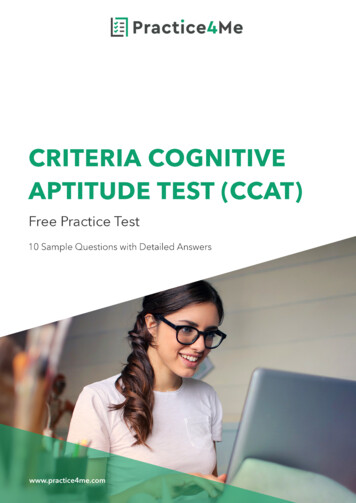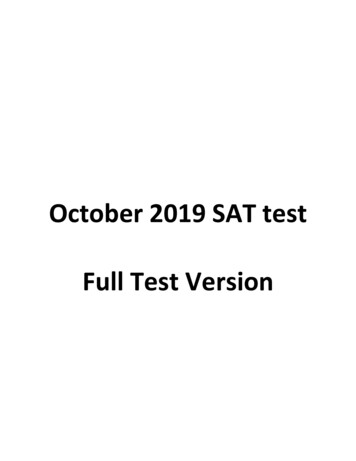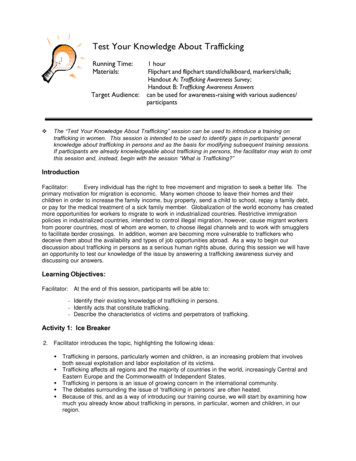
Transcription
Test Your Knowledge About TraffickingRunning Time:Materials:Target Audience:v1 hourFlipchart and flipchart stand/chalkboard, markers/chalk;Handout A: Trafficking Awareness Survey;Handout B: Trafficking Awareness Answerscan be used for awareness-raising with various audiences/participantsThe “Test Your Knowledge About Trafficking” session can be used to introduce a training ontrafficking in women. This session is intended to be used to identify gaps in participants’ generalknowledge about trafficking in persons and as the basis for modifying subsequent training sessions.If participants are already knowledgeable about trafficking in persons, the facilitator may wish to omitthis session and, instead, begin with the session “What is Trafficking?”IntroductionFacilitator:Every individual has the right to free movement and migration to seek a better life. Theprimary motivation for migration is economic. Many women choose to leave their homes and theirchildren in order to increase the family income, buy property, send a child to school, repay a family debt,or pay for the medical treatment of a sick family member. Globalization of the world economy has createdmore opportunities for workers to migrate to work in industrialized countries. Restrictive immigrationpolicies in industrialized countries, intended to control illegal migration, however, cause migrant workersfrom poorer countries, most of whom are women, to choose illegal channels and to work with smugglersto facilitate border crossings. In addition, women are becoming more vulnerable to traffickers whodeceive them about the availability and types of job opportunities abroad. As a way to begin ourdiscussion about trafficking in persons as a serious human rights abuse, during this session we will havean opportunity to test our knowledge of the issue by answering a trafficking awareness survey anddiscussing our answers.Learning Objectives:Facilitator:At the end of this session, participants will be able to:- Identify their existing knowledge of trafficking in persons.- Identify acts that constitute trafficking.- Describe the characteristics of victims and perpetrators of trafficking.Activity 1: Ice Breaker2.Facilitator introduces the topic, highlighting the following ideas:w Trafficking in persons, particularly women and children, is an increasing problem that involvesboth sexual exploitation and labor exploitation of its victims.w Trafficking affects all regions and the majority of countries in the world, increasingly Central andEastern Europe and the Commonwealth of Independent States.w Trafficking in persons is an issue of growing concern in the international community.w The debates surrounding the issue of ‘trafficking in persons’ are often heated.w Because of this, and as a way of introducing our training course, we will start by examining howmuch you already know about trafficking in persons, in particular, women and children, in ourregion.
3.Facilitator displays the continuum scale and gives the participants the following instructions:w Consider how much you know about the problem of trafficking in persons and the laws thataddress trafficking.w In a moment, I will ask you to rate your knowledge level about trafficking in persons on a scalefrom 1 to 10 where 1 means you lack any knowledge and 10 means you know everything there isto know about trafficking in persons.Prepare a flipchart sheet with a continuum scale prior to the exercise.4.Facilitator asks participants to think where they are on the scale and place a check under theappropriate number on the flipchart.5.Facilitator leads a discussion using the following questions to guide the group:Ø What does the scale indicate about this group’s awareness of the issue of trafficking in persons?Ø How much exposure have you had to information about trafficking in persons in the last year(through mass media or otherwise)? Have you been engaged in discussions about the issuebefore today’s session?Ø What impact has this information or discussions had on you?Activity 2: Trafficking Awareness1.2.Facilitator distributes copies of the Handout A: Trafficking Awareness and allows participants 10-15minutes to answer the questions.Facilitator reviews the survey question by question, leading a discussion about participants’ replies.v Do not give the participants the correct answers until they have had a chance to debate with eachother. See the answer sheet for information about answers.3.Facilitator distributes copies of the Handout B: Trafficking Awareness Answers and allowsparticipants time to check their replies against the answers and discuss the differences.Summary and Closing:Facilitator closes by asking each participant to share how they feel about exploring trafficking in a morein-depth manner.Questions and Comments:Facilitator should end the session by asking if there are remaining questions or comments related to thismaterial. Keeping track of feedback will allow the facilitator to make useful changes to futurepresentations.It would be helpful to ask participants to generate a list of questions they have about trafficking in women.Facilitator should record these questions and make sure all of them are answered by the end of thetraining workshop.Copyright 2003 Minnesota Advocates for Human Rights; available from http://www.stopvaw.org.Permission is granted to use this material for non-commercial purposes. Please use proper attribution.
HANDOUT ATrafficking Awareness Survey1. When I think of the term ‘trafficking in persons’:q I’m not sure what it is.q The definition is confusing and unclear to me.q I’m not sure about the difference between trafficking and forced migration.q I think of trafficking in persons as synonymous with smuggling.q I understand the act it defines.2. Trafficking in persons can involve which of the following (check all that apply):q Voluntary migration with deception or coercionq Exploitationq Abuse of power or of a position of vulnerabilityq Transfer or reception of people by force or threatq Crossing of international bordersq Consent to be brought across the borderq Movement within bordersq Voluntary labor migration for sex workq Forced labor/forced prostitutionq Debt bondage (i.e. a person if forced to work as a means of “repayment” of a loan, or fees for services.Generally, the fee is increased, making it impossible to pay, or the value of the labor exceeds the originaldebt.)qqqqRestriction of personal freedomConfiscation of legal identityInvoluntary servitude or slavery-like conditionsViolence or threat of violence3. Most trafficked persons from the CEE/CIS region are/have (check all that apply):AgeResidenceq Residents of rural areasq Residents of urban areasFamily Situationq Singleq Marriedq Divorcedq Single mothers who are sole providersfor their familiesq Women who come from nuclear familiesand have good relationships with theirparents or their husband/partnerq Survivors of domestic violence, sexualabuse or sexual harassmentEducationq University graduatesq UndereducatedEmploymentq Never worked beforeq A professional backgroundqqqqqqWomen over 30Teenage girls between 14-17Teenage boys between 14-17Women between 18-24Middle-aged menYoung childrenSocio-Economic Statusq Poorq Average incomesq Well-off
4. The “typical” recruiter is (check all that apply):q Femaleq Maleq Both, male and femaleq Acquaintanceq Strangerq Friendq Boyfriendq Neighbor/family friendq Relativeq Husbandq Childq Private companies5. People are recruited into trafficking through which of the following methods (check all that apply):q Kidnappingq False job promise (e.g. through advertisements in the newspapers)q False invitation abroadq False travel arrangementsq False promise of marriageq Genuine promise of legal employment opportunities6. Once victims find themselves in the middle of the trafficking process (check all that apply):q It is easy to control it and escape when they choose to do so.q They experiences lack of control over movement.q They are treated kindly and with respect.q Their personal belongings, passport and money are seized.q In most cases, they experience mental abuse.q More than half of the victims are sexually abused by their traffickers/exploiters or thetraffickers/exploiters’ friends.q They are often forced to live in shared accommodations with poor hygienic conditions and limitedaccess to food.q They are often kept locked in their accommodations during the day and are forced intoprostitution at night.q They are never forced to have unprotected sex with clients.q They are almost never physically abused.True or false (Circle one):TF 7.Trafficked persons often make a conscious decision to go abroad hoping to find a better life.TF 8.Trafficked women are sometimes partly or fully aware of the possibility of being involved incommercial sex work.TF 9.Trafficked women expect to be held as slaves and do not assume they will be choosing theirworking conditions.TF 10. Trafficked persons most often want to go abroad to find a job.TF 11. Trafficked persons receive good payments for their services and enjoy generous benefits.TF 12. Most trafficked women receive medical care on an emergency basis only, especially whenthe symptoms could affect their “performance.”TF 13. Trafficked women are mostly young, naï ve and uneducated women from rural areas.
HANDOUT BTrafficking Awareness Answers1. This question is intended to help people think about their knowledge of trafficking in persons. Theonly false response is that “trafficking in persons is synonymous with smuggling.” In reality, there is afundamental difference between smuggling and trafficking. Smuggling is voluntary labor migrationthrough illegal facilitation and involves taking a person across a border for a fee; whereas traffickinginvolves movement of a person across or within borders, forced or voluntary with deception andcoercion, into a situation of forced labor, servitude or slavery-like practices.2. The only answer that is not part of the definition of trafficking is “voluntary labor migration for sexwork.” All the others can constitute, or are part of, trafficking in persons.3. Most trafficking victims from the CEE/CIS region have the following characteristics, but keep in mindthat other types of people, with other backgrounds, can also be vulnerable to trafficking.Age: Most trafficking victims from CEE/CIS are women between the ages of 18-24. Women fromother age groups are also vulnerable to trafficking. It is least likely for middle-aged men to betrafficked, although men of this age group may migrate illegally for work purposes.Residence: Trafficking victims come from both rural and urban areas, and so there is no clearpredictor based on residence.Education: Both university-educated and undereducated women can become victims oftrafficking. In fact, according to some women, they were approached about working abroad whilestudents at university. Undereducated women, however, tend to have fewer employmentopportunities and therefore may be more vulnerable to trafficking.Socio-Economic Status: Generally, poor women are the most vulnerable to trafficking, becausethey lack other avenues for supporting themselves and their families. However, even women ofaverage income can become involved in trafficking when seeking employment opportunities.Family Situation: Most trafficking victims from CEE/CIS are single (sometimes through divorce orseparation), many of whom are single mothers and the sole providers for their children. Other formsof violence against women, such as domestic violence, sexual abuse or sexual harassment, increasethe risk of trafficking occurring. Women who come from nuclear families and have good relationshipswith their parents or their husband/partner are less likely to become trafficked.Employment: Studies suggest that the majority of trafficking victims have a professionalbackground, and have previous work experience in various sectors in their home countries and/orabroad.4. The only answer that does not apply in this case is “child.”5. They only answer that does not apply here is “genuine promise of legal employment opportunities.”Recruitment for trafficking through genuine promise of opportunities is a contradiction in terms.Recruitment of persons for trafficking always involves deception or coercion.6. The answers that do not apply are:üIt is easy to control it and escape it when they choose to do so.
- It is extremely difficult for the trafficked victims to have control over the trafficking process.Usually, their personal belongings and money are seized and the victims are under constantpsychological and physical pressure and abuse.üThey are treated kindly and with respect.- The victims’ human rights are violated and they are deprived of personal freedoms.üThey are never forced to have unprotected sex with clients.-üMany victims are forced into unprotected sex. Medical care was normally given on anemergency basis only.They are almost never physically abused.- According to an International Organization for Migration (IOM) Kosovo Counter Trafficking UnitSituation Report, 74.4% of the trafficked victims that were assisted by the IOM in Kosovo fromFebruary 2000 to September 2002, were beaten by their traffickers or exploiters; 58.4%reported to be sexually abused by their traffickers/exploiters or the traffickers/exploiters’ friends.(report available from o sit report.pdf).7. True. Unemployment and poverty in the victims’ home countries and higher income and livingstandards in the destination countries often act as powerful factors in a victim’s decision to workabroad. Tempting offers or seemingly legitimate job advertisements then lead the victim into thehands of the traffickers.8. True. According to the IOM report cited above, 22.6% of the assisted trafficked victims were partiallyor fully aware of the possibility of being involved in commercial sex work.9. False. None of them would ever expect to be held as slaves and all of the victims assumed theywould be choosing their working conditions.10. True. According to the IOM report cited above, 82.6% of the assisted trafficked women named findinga job as their main reason for going abroad.11. False . As the IOM report states, trafficked victims usually receive neither profits, nor other workrelated benefits. Only 4% of the assisted women reported receiving regular payment for their work.Few of the women receive modest occasional allowances (49.1%), which often they generally had tospend to pay for their rent, food and clothes.12. True . Medical care is normally given to the trafficked victims on an emergency basis only. The IOMreport states that 33.3% of the trafficked victims that were assisted by the IOM in Kosovo fromFebruary 2000 to September 2002, were denied medical attention. The majority of the womenassisted were found to have become infected with sexually transmitted diseases when examined intheir country of origin.13. False . According to the IOM report cited above, 52.17% of the assisted trafficked victims come formurban areas and most of them (76.1%) have a professional background, i.e. they had previousworking experience in various sectors in their home countries or/and abroad. Victims who wereassisted in Kosovo came from all age groups, some had very basic education, others were universitygraduates. Many were single mothers, supporting their children alone.Copyright 2003 Minnesota Advocates for Human Rights; available from http://www.stopvaw.org.Permission is granted to use this material for non-commercial purposes. Please use proper attribution.
Test Your Knowledge About Trafficking Running Time: 1 hour Materials: Flipchart and flipchart stand/chalkboard, markers/chalk; Handout A: Trafficking Awareness Survey; Handout B: Trafficking Awareness Answers Target Audience: can be used for aware ness-raising with various audiences/ participants v The “Test Your Knowledge
